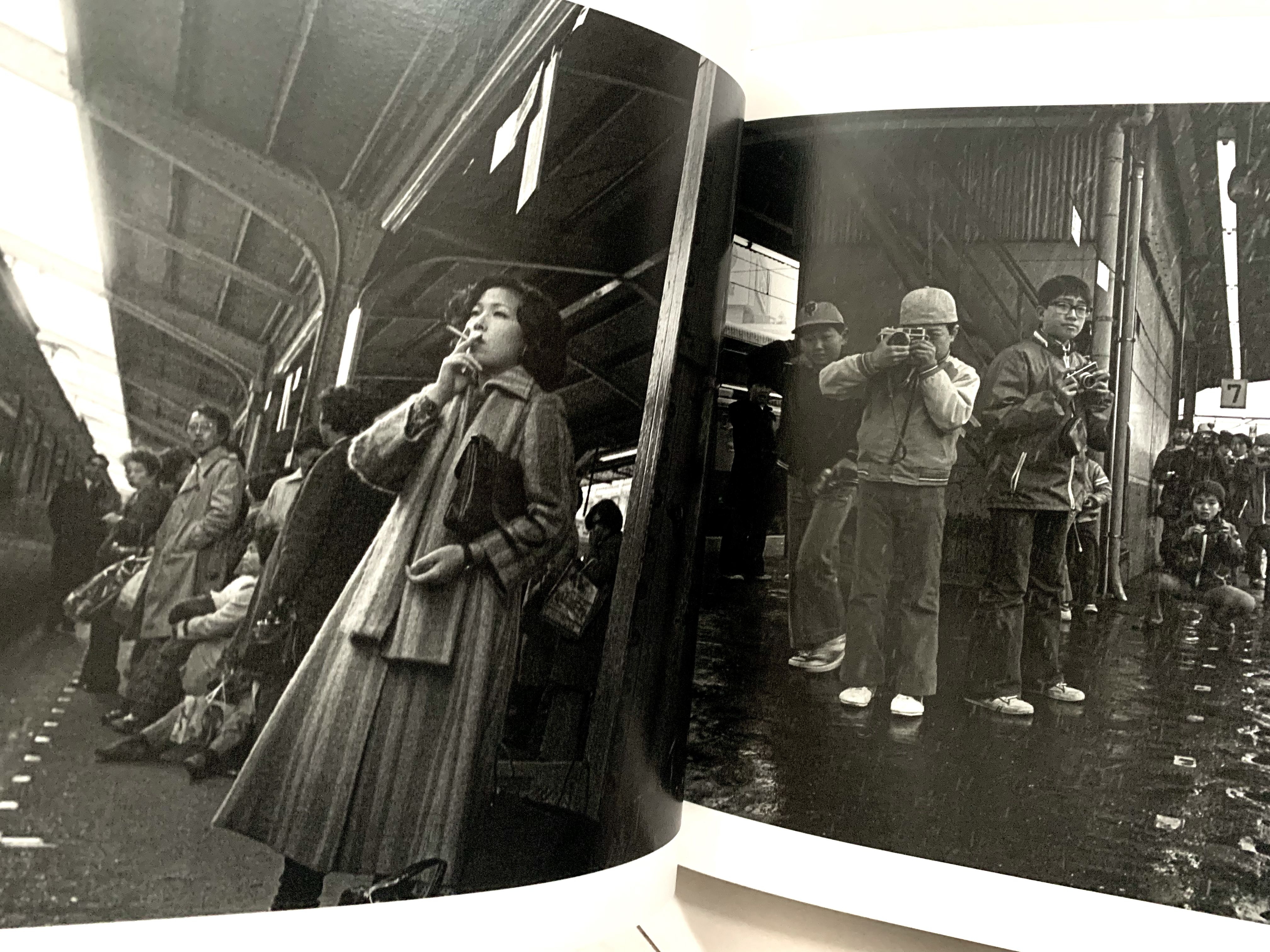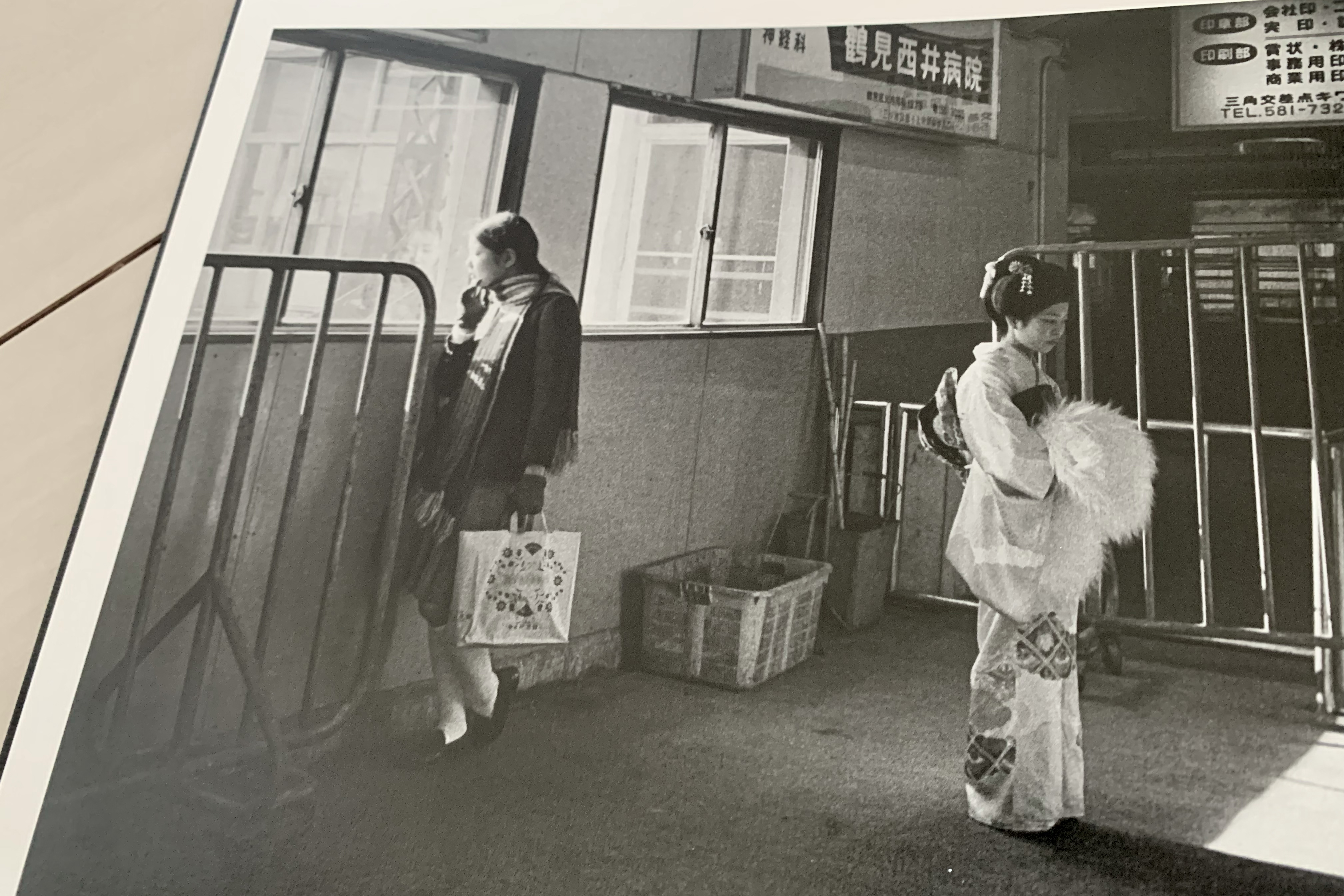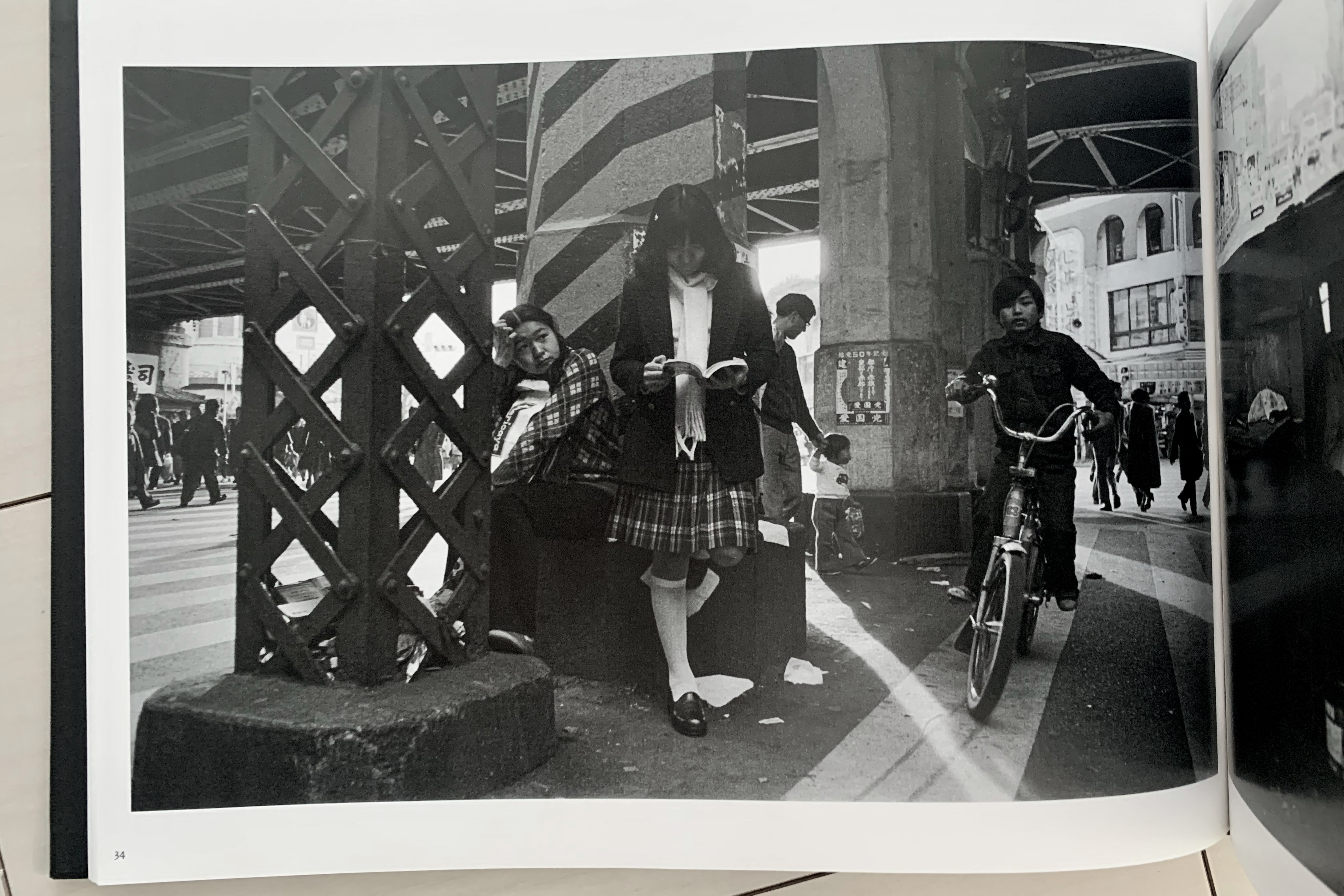コラム
落合憲弘
John Sypal
タカザワケンジ
なぎら健壱

Despite being released in 2019, this week’s book is, in terms of existing copies, perhaps the rarest one in my collection. Of course, this is mostly by default- the photographer only had 25 copies printed.
Published under the Place M imprint, “The Station 1974-77” is a fantastic collection of photographs taken in and around Japanese train stations by Shigeru Yamazaki between- you guessed it- 1974 and 1977.
Mass transit hubs like airports and train stations have long been photographic goldmines (silvermines?) for human spectacle and drama- the stuff of interesting pictures. Here even the banal is heightened- there’s a difference between someone sitting alone in a park compared to one sitting alone on an empty station platform bench.
In the 70s, Yamazaki, then just 23, saw Tokyo’s train stations as stages- self-generating plays where each and every element was cast in an important, irreplaceable part. With camera in hand he explored the peculiar phenomena found within them. Here he discovered an ecosystem of concrete and trains but also societal rules and small economies and the actions and gestures of its human inhabitants. Not limiting himself to the station proper, Yamazaki also wandered from station exits out into the surrounding mazes of bars and shops and alleys. His pictures are populated by a menagerie commuting salarymen, noodle-shop cooks, bargirls, newsstands, fortune tellers, unattended children, housewives, stooped elderly, out of towners, forlorn travelers, bored smokers, readers of every sort, and shoe shiners. (Where did they all go?)
These “actors” are folks with places to go and people to be- often in home or the office- but caught within his frames are people whom inhabit an in-between sort of dimension. The average salaryman might consider the station as merely a tolerable part of his commute, but, making his way through it he nevertheless passes others who are on longer journeys. In a station is by nature a sort of midway point- it’s neither here nor there- well, “here”, I suppose- but not the “there” which these people are headed. This sense of limbo is palatable in large stations like these. Many in Yamazaki’s pictures break this time up with a book or bowl of noodles but others sit with a pensive stillness- one which I suppose most people feel in these moments- something which wavers between boredom and apprehension. The book’s cover image illustrates well how such places allow the eyes and mind wander.
Many of the stations in the book are readily identifiable. Ueno station, the major terminal for Northern Japan to enter Tokyo, makes many appearances in these pages. Upon my first viewings of the book, I thought that every photo was of Ueno. Upon closer inspection I could make out Shinjuku and Shibuya stations as well. As you turn the pages, all of these massive, sprawling stations meld together. Their individuality (which they each truly possess) are negated by similarities of the people who use them. In a sense, Yamazaki photographed but one Station, a wheezing, sometime slippery and always noisy gigantic maze of hallways, a never-ending complex peppered with cafes, impossibly small shops, and railway platforms all coated in that 1970’s era patina of dusty grime and cigarette butts.
Trains themselves make appearances in the pages but they’re rarely the focus- and never romanticized. Of course, I say this as a photographer myself- and one admittedly uninterested in trains as symbols. The fact that this book isn’t a direct documentation of the trains themselves turn away railway aficionados but I can imagine the book being of great interest to postwar-era social historians and any Japanese 65 and older. The past comes alive- the scenes and locations here are places many passed, but few photographed.
You’ve probably noticed by now in my columns that the stuff in this book is right up my alley- postwar Japanese black and white photography of the social-landscape sort, by a relatively unknown photographer- glimpses into a recent past, one with looser rules and better-looking cars and fashion. What else is different here than these places today?
I feel there’s a roughness in these photos- but it’s not on the part of the photographer, as his lens is curious if not kind. It’s not that the subjects as individuals are rough (well, some could be) but rather perhaps it’s the mood of society at that time. This was an age before security cameras and roving security staff asking people to stop sitting on the floor- the war had only ended some thirty years prior. With any book from the post-war era, I can’t help but reflect on the fact that anyone in these pages over 35 or 40 experienced World War 2 and the following hard years of the nation’s reconstruction. (This would be the 1990’s to 2022…)
Since “rephotography” is a hobby of mine, I couldn’t help but make a quick trip to Ueno station to re-photo two images from this book. The ramp down to the Hibiya & Ginza lines was obvious- the correct pillar in the second pic only took a little bit of searching for. Sadly it was blocked off with construction barriers. I’d like to find more locations in this book in the future.
As I said in the intro- I was told that The Station 1974-77 was printed in a single run of 25 through an on-demand printing company in Tokyo. The reproductions can be a bit muddy at times, but their soul shines through. The printing is adequate, but a larger run with a skilled offset printing director would no doubt result in a book that would be of interest to photographers and lovers of Tokyo around the world.
Finally, despite the fact that Yamazaki took these images in his early 20s, his biography at the end of the book lists that his first solo show wasn’t until he exhibited another series, “The Gentlemen and Ladies of Downtown”, at the Nikon Salon in 2013. He was 62.
I know that there’s got to be more great photography out there still- in Yamazaki’s archives as well as the albums and closets of older photographers all across Japan.
It’s my hope that photography is able to be further enrichened with more pictures- and photographers- coming to light.

2019年に発売されたにもかかわらず、今週の本は現存する部数で言えば、おそらく私のコレクションの中で最も希少な一冊です。これは写真家が最初から25部しか印刷しなかったからなのですが。
Place Mから出版された『The Station 1974-77』は、山崎茂が1974年から1977年にかけて日本の駅とその周辺で撮影した素晴らしい写真集です。
空港や駅のような交通の要所では、昔から人間のスペクタクルやドラマを撮影するための金鉱がありました。公園で一人で座っている人と駅のホームのベンチで座っている人とでは、ありふれたものであっても、その存在感は大きく違ってくるのです。
当時まだ23歳だった山崎氏は、東京の駅を舞台としてとらえ、そのひとつひとつがかけがえのない重要な役柄であり、自己生成する演劇であると考えたそうです。その中で起こる奇妙な現象をカメラを片手に探りました。彼はここで、駅(建物)や電車だけでなく、社会ルールや小さな経済、そこに居る人々の行動やジェスチャーからなる生態系を発見したのです。
山崎氏は駅構内にとどまらず、駅の出口から周辺のバーやショップ、路地など、迷路のように入り組んだ場所にも足を運びました。通勤するサラリーマン、ラーメン屋の店主、飲み屋の女将、新聞販売店、占い師、子ども、主婦、腰の低い老人、よそ者、寂しい旅人、退屈な喫煙者、あらゆる種類の読者、靴磨き屋などが彼の写真に登場します(靴磨き屋の皆さんはどこに行ったんだろう?)。

この「役者」たちは、行くべき場所があります。それは家や会社であることが多いのですが、山崎氏のフレームには、その中間の次元に居る人たちが収まっています。サラリーマンは、駅を通勤のための許容範囲と考えているかもしれませんが、それでも彼は、旅に出る人々とすれ違います。
駅というのは本来、「ここ」でも「あそこ」でもなく、中途半端な場所なのです。その中途半端さが、このような大きな駅では心地よく感じられます。山崎氏の写真には、本や麺類で時間を過ごす旅行者も多く写っていますが、物思いにふけりながら座っている人もいます。

この本の表紙の写真は、このような場所や時間がいかに目を楽しませ、心を迷わせることをよく表しています。
この本に北日本から東京への主要なターミナルである上野駅が何度も登場しますが、その他の東京の駅もいくつか登場します。実はこの本を最初に見たときは、どの写真も上野だと思っていました。しかしよく見てみると、新宿駅や渋谷駅も写っているのです。
ページをめくると、さまざまな駅の写真が「The Station」となっています。ある意味山崎氏はひとつの駅を撮影したのです。喘ぐように、時に水溜りで滑りやすく、常に騒がしい巨大な廊下の迷路、カフェやどうしようもなく小さな店、駅のプラットフォームが散りばめられた、1970年代の埃とタバコの吸殻に覆われた複合施設。
電車が登場することはあっても、それがメインの被写体ではないし、さらにその電車がロマンチックに描かれることもありません。余談ですが、電車が登場しないので電車好きの人は敬遠するかもしれませんが、戦後の社会史研究者や65歳以上の日本人にとって非常に興味深い写真集だと思います。

このコラムを読んでいる方は、このような本が私の好みにぴったりだとすぐ分かると思います。やっぱり、戦後の日本のモノクロ写真で、ソーシャルランドスケープ、ルールが今より緩く、車やファッションが格好良く、最近の過去を垣間見ることができるもので、もう、たまらないです。最高!
この写真群には少し荒々しさを感じますが、それは写真家の側ではありません。山崎氏のレンズは優しくはないにしても好奇心が強いからです。被写体個人が荒っぽいということではなく(まあ、ラフな人もいるでしょうが)当時の社会の雰囲気なのでしょう。
戦争後30年、このページに写っている35歳〜40歳以上の人は第二次世界大戦とその後の復興期を経験した人であることを考えざるを得ません(そういえば、2022年の30年前は…1990年代!)・
私の趣味のひとつは「Re Photo(リーフォト)」なので、この本の中の2枚の写真を撮り直すために、上野駅へ急行しました。日比谷線と銀座線に降りるスロープは分かりやすかったです。


2枚目の写真に写っている柱を少し探しただけで見つかりました。周りが工事中だったので、山崎氏の写真ほどちかづけられませんでしたが、今後もっと多くの場所で「リーフォト」してみたいと思います。


冒頭で述べたように、この本はオンデマンド印刷会社で25部ずつ印刷されたものだと思います。印刷は十分ですが、もっと大量に、しかも腕のいいオフセット印刷のディレクターに頼めば、もっといいものができるでしょう。そうすれば、世界中の写真家や東京を愛する人々の興味を引くような本になるに違いないです。
最後に、山崎は20代前半にこれらの写真を撮っているにもかかわらず、巻末の略歴には、最初の個展は2013年、ニコンサロンで別のシリーズ「下町の紳士淑女」だと記されています。62歳のときでした。
山崎さんのアーカイブはもちろん、日本中の先輩写真家のアルバムやクローゼットには、まだまだ素晴らしい写真があるはずです。より多くの写真、写真家の存在が明らかになることで、「photography」という世界がより豊かになることを願っています。
- Shigeru Yamazaki "The Station 1974-77"
Published by Place M, 2019- 山崎 茂『THE STATION 1974-77』
- 発行:PlaceM
発売:2019年7月20日
判型:W297mm x H220mm 写真62点
印刷・製本:株式会社イニュニック
ISBN:978-4-905360-27-8 C0072
価格:税抜4,000円- https://shop.placem.com/items/35478389


PCT Membersは、Photo & Culture, Tokyoのウェブ会員制度です。
ご登録いただくと、最新の記事更新情報・ニュースをメールマガジンでお届け、また会員限定の読者プレゼントなども実施します。
今後はさらにサービスの拡充をはかり、より魅力的でお得な内容をご提供していく予定です。
 「Photo & Culture, Tokyo」最新の更新情報や、ニュースなどをお届けメールマガジンのお届け
「Photo & Culture, Tokyo」最新の更新情報や、ニュースなどをお届けメールマガジンのお届け 書籍、写真グッズなど会員限定の読者プレゼントを実施会員限定プレゼント
書籍、写真グッズなど会員限定の読者プレゼントを実施会員限定プレゼント